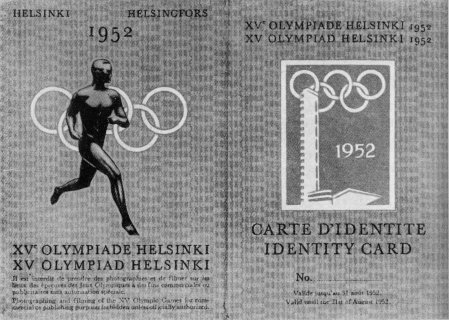Identity Card
IDENTITY CARDS Identity Cards, or Olympic Passports as they were also called, were issued to all persons on official duties or of official status and to all competitors. In view of the favourable experience gained at the London Games the Organising Committee took measures to have the Olympic Identity Card recognised as valid as a travel passport. Negotiations with the Passport Department of the Ministry of Foreign Affairs and the Aliens Department of the Ministry of the Interior led to positive results. By a Decree issued on Feb. 1st 1952 aliens were permitted to enter Finland and stay in the country between June 1st and Aug. 31st 1952 without visas and Olympic Passports were exempted from visa formalities as from March 1st, from which date their validity was six months. The Card served in lieu of a regular passport only in cases where the government of the country concerned consented to its use as an official travel document and transit visa. This was done by 32 countries. Olympic Identity Cards were of three kinds: I. Green Identity Card Green Identity Cards were issued to the following: 1. Members and staff of the I.O.C. The green Identity Card entitled to entry to all venues. A pass card
appended to the II. Blue Identity Card Blue cards were issued to: 1. Representatives of National Olympic Committees The blue card entitled to entry to Olympic Villages, stands reserved
for competitors and III. Orange Identity Card This, the so-called Press Card, was issued to: 1. Journalists 
Green Identity Cards
298 How many green and blue cards were in actual use it is impossible to
say, for the National Olympic Committees generally neglected to return
superfluous cards. On the other hand, new Identity Cards had to be made
out for the entire membership of a few teams on their arrival in Helsinki,
the original consignments having failed to reach their destination. Other Identity Cards and Passes The entry of Finnish officials to venues, training sites and housing centres was arranged by the issue of the following identity cards and passes: 1. Black Identity Card (with photograph attached) issued to persons in the service of the Organising Committee whose duties were of a kind involving movement everywhere 2 Red Identity Card (with photo) issued to sports officials and entitling to entry to specific venues only 3 White Identity Card with entries in red but no photo, serving as a
pass for the performance of the duty 4 Armlet with printing (in Finnish) »Messenger», »Vendor» or »Restaurant» entitling persons engaged in these tasks to proceed to their place of work at a venue 5 Pass Certificate issued to persons carrying out transport to venues. (Source Document: Official Report 1952, page 155) |